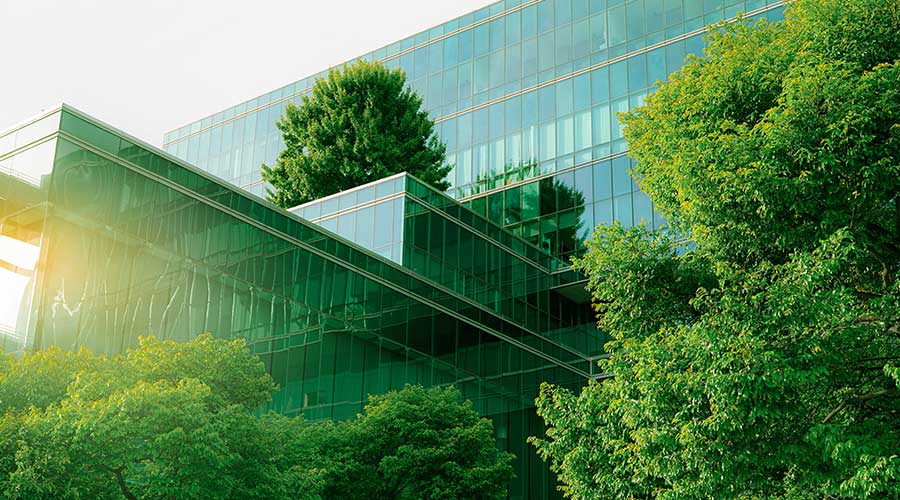Making a Building LEED-CI Ready
As the economy has taken its toll on new construction, many organizations are looking for new strategies to give their existing buildings a competitive edge. Owners and facility managers continue to look for new items to incorporate into their facility that will create a new image for their space. Annual maintenance and replacement of building components at the end of their service lives should not be ignored, of course. But building owners frequently are looking for additional ways to set their facilities apart from their neighbors.
The U.S. Green Building Council's LEED for Commercial Interiors (LEED-CI) rating system is one guideline building owners should consider for multitenant buildings. By preparing a base building in such a way as to make it easy for tenants to earn LEED-CI certification in their own space, building owners can find that competitive advantage they seek. The strategies spelled out in LEED-CI will not usually earn LEED credits for the base building under LEED for Core and Shell certification, but LEED-CI and LEED-CS do complement each other nicely, and the strategies can be a good lure for new tenants and a reason for existing tenants to re-sign.
Site Improvements
When re-doing parking lots or landscaping at a facility, choose parking island trees that provide shade (or will provide shade within a few years of landscape installation). Also, use materials that are light-colored and have high-albedo surface reflectivity of the sun's radiation — materials with a Solar Reflectance Index (SRI) of at least 30. SRI is a measure of a surface's ability to reject solar heat.
Another good option is an open-grid pavement that individually or in total equals at least 30 percent of the site's non-roof impervious surfaces. This includes parking areas, walkways, plazas and fire lanes. Or use an open-grid pavement system (less than 50 percent impervious) for 50 percent of the parking lot area. These improvements would qualify for a point under LEED-CI, Sustainable Sites (SS) Credit 1, Path 4 — Heat Island Effect, Non-Roof.
When re-roofing buildings, choose roofing materials that have a Solar Reflectance Index (SRI) greater than or equal to 78 for low-sloped roofs or 29 for steep-sloped roofs for a minimum of 75 percent of the roof surface. Another option is to install a "green" (vegetated) roof for at least 50 percent of the roof area. Either improvement would qualify for a point under LEED-CI, SS Credit 1, Path 5 — Heat Island Effect, Roof.
When replacing site lighting, select exterior fixtures that meet or provide light levels and uniformity ratios recommended by the Illuminating Engineering Society of North America's (IESNA) "Recommended Practice Manual: Lighting for Exterior Environments (RP-33-99)." These requirements state that the building must have exterior lighting and luminaires with more than 1,000 initial lamp lumens. These lamp lumens should be shielded, and all luminaires with more than 3,500 initial lamp lumens must meet the Full Cutoff IESNA Classification. Any luminaire within a distance of 2.5 times its mounting height from the property boundary should have shielding with no light from that luminaire that crosses the property boundary. This improvement would qualify for a point under LEEDÐCI, SS Credit 1, Path 6 — Light Pollution Reduction.
When considering landscaping, it is recommended to use high-efficiency irrigation technology, captured rain or recycled site water to reduce potable water consumption for irrigation by 50 percent over conventional means. This improvement would qualify for a point under LEEDÐCI, SS Credit 1, Path 7 — Water Efficient Landscaping.
When upgrading or expanding the facility amenities, provide secure bicycle storage with convenient changing and shower facilities within 200 yards of the building for 5 percent or more of the tenant occupants measured at peak periods. Provide shower and changing facilities in the building or within 200 yards of a building entrance for 0.5 percent of Full-Time Equivalent (FTE) occupants of the entire building. This qualifies for two points under LEEDÐCI, Credit 3.2 — Alternative Transportation, Bicycle Storage & Changing Rooms.
Provide preferred parking for carpools or vanpools capable of serving 5 percent of the building occupants, and you qualify for two points for SS Credit 3.3 — Alternative Transportation, Parking Availability.
Water Efficiency
When upgrading building plumbing systems, replace plumbing fixtures with low-flow fixtures or ultra-low flow fixtures so that the building will meet the 20 percent reduction in water use requirement for the entire building. The baseline is based on industry standard baselines for individual fixtures — 1.6 gpf for toilets, for instance. Then create an ongoing plan with which future occupants must comply. This improvement would qualify for between six (for a 30 percent reduction) and 11 (for a 40 percent reduction) points under LEEDÐCI, WE Credit 1.1 — Water Use Reduction.
Energy and Atmosphere
Regarding building-level HVAC systems, conduct an inventory to identify equipment that uses CFC refrigerants and replace or retrofit these systems with non-CFC refrigerants. This complies with Energy & Atmosphere Prerequisite 3 — Fundamental Refrigerant Management. Prerequisites are minimum requirements that must be met to qualify to submit a project for LEED certification.
Install any new HVAC system that complies with the efficiency requirements outlined in the New Buildings Institute's publication "Advanced Buildings: Energy Benchmark for High Performance Buildings (E-Benchmark)." Another path is to reduce HVAC energy use by 15 percent compared to ASHRAE 90.1-2007 (tenants would earn 5 points) or 30 percent (tenants would earn 10 points). These strategies fall under LEED-CI, EA Credit 1.3 — Optimize Energy Performance, HVAC.
Material and Resources
To meet the requirements of Materials & Resources Prerequisite 1 — Storage & Collection, designate an area of the building for recyclable collection and storage that is appropriately sized and located in a convenient area.
Additionally, identify local waste handlers and buyers for glass, plastic, office paper, newspaper, cardboard and organic waste. Instruct occupants on building recycling procedures. Consider employing cardboard balers, aluminum can crushers, recycling chutes and other waste management strategies to further enhance the recycling program. When negotiating leases, focus on getting the occupant to commit to a lease for at least 10 years. This qualifies for one point with MR Credit 1.1 — Tenant Space, Long-Term Commitment.
Other Materials & Resources credits can be achieved by working carefully on reusing parts of the building and helping tenants to select rapidly renewable materials and certified wood.
Indoor Environmental Quality
Prohibit smoking on the property and minimize exposure of non-smokers to environmental tobacco smoke (ETS) to meet EQ Prerequisite 2 — ETS Control.
Help tenants develop an indoor air quality management plan during construction and before occupancy to earn one point each. Give them options for selecting low-emitting materials, such as paints, adhesives and sealants, and flooring to earn IEQ Credits 4.1-4.5.
Show them how controllability of lighting and thermal systems can benefit both their energy use and their occupant satisfaction, as well as earn IEQ Credits 6.1 and 6.2 — Controllability of Systems. Providing daylight to 90 percent of occupants can earn them two points with IEQ Credit 8.1.
Other Options
For multitenant commercial office buildings, the owner's best option for base-building certification is to pursue LEED Core and Shell (LEED-CS). This would allow an owner to achieve a certification for the facility that tenants could use as a guaranteed five credits toward their LEED-CI applications.
Another recognized standard of achievement is Energy Star status. This system evaluates a building from an energy standpoint against national standards.
Julie Trott is a registered architect in nine states and a LEEP Accredited Professional. Trott is engaged in exterior architectural design and project implementation at Vocon, a Cleveland-based architecture and interior design firm. Her experience ranges from sustainable projects to retail, broadcast, historical buildings, health care and hospitality on a national level.
Related Topics:













